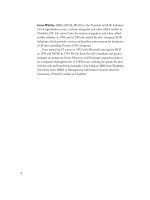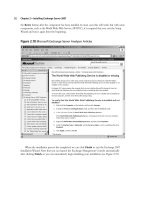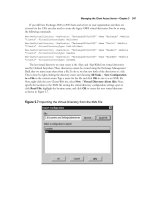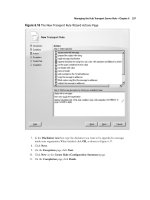Exchange SQL And IIS- P105 pptx
Bạn đang xem bản rút gọn của tài liệu. Xem và tải ngay bản đầy đủ của tài liệu tại đây (325.83 KB, 5 trang )
High Availability for Exchange 2007 Mailbox Servers • Chapter 8 497
When the log fi les have been verifi ed, we can move on to checking the integrity of the
database copy. This is also done by running Eseutil with the /k switch but instead followed by
the full path the database copy. In this example, we need to run the following command:
Eseutil /k “E:\Mailbox\LocalCopies\First Storage Group\Mailbox Database.edb”.
Eseutil will once again initiate checksum mode and then create a temporary database so that the
database copy can be checked for any errors (see Figure 8.23). Again, the time required for the
integrity check depends on the size of the database.
When you have performed an integrity check of both the log fi les and the database copy (and
hopefully Eseutil.exe hasn’t found too many corrupted log fi les or issues with the database copy), you
should make sure that LCR for the respective storage group is resumed again. Should you be so unlucky
that Eseutil.exe fi nds one or more corrupted log fi les or corruption in the database copy, you need to
disable LCR on the storage group, then remove the corrupted log fi les and/or database copy fi le. When
the fi les have been removed, you can re-enable LCR, which will create a database copy and seed it as
well as replicate any existing log fi les from the active copy of the storage group to the specifi ed path.
Figure 8.22 Integrity Check of the LCR Log Files
498 Chapter 8 • High Availability for Exchange 2007 Mailbox Servers
We’ll bet that most of you understand the importance of during periodically integrity checks of
both the log fi les as well as the database copy—right?
Disabling Local Continuous Replication
on a Storage Group
There might come a time when you no longer want to have the LCR feature enabled for a
particular storage group. Luckily, it’s a painless process to disable this feature once it’s enabled.
You can disable LCR for a storage group via either the EMC or the EMS. To disable LCR using
the EMC, you need to select the Storage Group level under the Mailbox subnode, located beneath
the Server Confi guration work center node; you then click Disable local continuous replication
in the Action pane, as shown in Figure 8.24.
Figure 8.23 Integrity Check of the LCR Database Copy
High Availability for Exchange 2007 Mailbox Servers • Chapter 8 499
Figure 8.24 Disable LCR Action Link
Figure 8.25 Disabling Local Continuous Replication Confi rmation
When we disable LCR for a storage group, we’ll get the warning message shown in Figure 8.25,
which tells us that LCR will be disabled for the replication database copy for the respective Storage
Group. Since this is exactly what we want to do, click Ye s .
After we click Yes, believe it or not we’ll get an additional warning message. This one informs us
that we must delete the fi les (that is, the log fi les, EDB database, and so on) manually from the path
(which in this example is E:\Mailbox\LocalCopies\First Storage Group) we specifi ed when we
originally enabled LCR (see Figure 8.26). Once you have clicked OK and deleted these fi les, LCR
has been properly disabled.
500 Chapter 8 • High Availability for Exchange 2007 Mailbox Servers
If you want to disable LCR for a Storage Group via the EMS, you need to do so using the
Disable-StorageGroupCopy CMDlet. To disable the LCR for the First Storage Group, type
Disable-StorageGroupCopy –Identity “First Storage Group”. When you do, you’ll get the
same warning message as the one shown in Figure 8.25.
Local Continuous Replication Performance
Objects and Counters
When the Exchange 2007 Mailbox Server role is installed, setup adds two LCR-related performance
objects to the Windows 2003 Performance Monitor. To open the Performance Monitor, either click
Start | Run and type Perfmon or click Start | Administrative Tools and select Performance.
This will bring up the Performance Monitor, shown in Figure 8.27.
Figure 8.26 Disabling Local Continuous Replication
High Availability for Exchange 2007 Mailbox Servers • Chapter 8 501
Figure 8.27 The Performance Monitor
The fi rst object is the MSExchange Replica Seeder performance object, which, as you can see in
Figure 8.28, contains only one counter, called Seeding Finished %. This counter is used to show the
progress of database seeding in percent. When you add this counter, you can choose which instance
(in this case, the particular storage group) you want to view the database seeding for.









